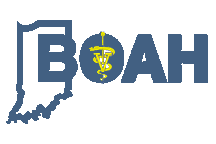The Indiana State Board of Animal Health (BOAH) would like to provide producers with resources for carcass disposal that may be used during a market disruption event.
Options for dead animal disposal in Indiana can be found here
On-Site Carcass Disposal Guidance
- Composting
On-farm composting is an option for livestock owners. By following a proven "recipe," an established on-farm composter can produce nutrient-rich organic matter suitable for field application in a few months. Dry organic material, like sawdust, is layered with animal remains to generate heat to speed decomposition. Carcasses are completely composted when no visible pieces of soft tissue remain. Large bones, such as a full-size skull or femur from adult livestock, should be removed and/or crushed prior to land application.
State law requires that domestic animals be kept from accessing the compost pile. Rodents and other wild animals are to be controlled so they do not disrupt the system or create a health hazard to humans or animals. This can be accomplished by surrounding the pile with a fence, placing it in a building, by covering the pile, or using an in-vessel composting system.
Run-on and leachate runoff must be prevented or controlled. The material must be thoroughly and completely composted. Under IDEM rules, confined feeding livestock facilities composting carcasses that are the result of routine mortalities at their operation must include the compost facility in their IDEM Confined Feeding Operation approval application. In the event an animal disease incident or natural disaster results in mass mortality at a confined feeding livestock facility, IDEM will support BOAH in identifying an appropriate location for temporary composting activities to manage the animal carcasses and related wastes.
Producers also have the option to transport carcasses to a common compost pile. Persons wanting to operate a communal compost pile, that accepts carcasses from outside sources, must obtain a Disposal Plant Permit from BOAH.
- Burial
Burial is another authorized means of disposal. By law, the entire carcass must be buried at least 4 feet below the natural surface of the ground. All body parts must lie under 4 feet of earth, not including other types of covering material (such as mulch). Livestock owners should take care to avoid burying remains near waterways, such as ponds and streams.
A city or town may have additional ordinances to regulate or prohibit burial within the city or town limits. Local authorities should be consulted to learn about local ordinances.
Fixed Location / Off-Site Carcass Disposal Guidance
- Rendering
A common option is removing carcasses to an approved disposal plant. Rendering can be a convenient, clean and waste-free solution that ultimately recycles the remains into other products. The renderer generally provides on-farm pick-up for a fee. Each company determines which species they will accept and geographic locations they will serve.
A list of licensed renderers in Indiana is available here
A list of rendering companies operating across the US is available here.
NOTE: Animals euthanized with pentobarbital cannot be rendered and should be identified. Preventing Pentobarbital Residues (North American Renderers Association)
- Landfill
Producers may also consider discarding dead animals at a local landfill. Landfill disposal qualifies as burial under BOAH rules. Each landfill operator decides what material it will accept. Please contact your local landfill for more information.
Carcass Disposal Resources
Further guidance for livestock disposal from the USDA and other agencies can be found at the following websites to assist in deciding what method of disposal will work best for your farm.
National Resources Conservation Service: Indiana (NRCS)
NRCS provides farmers and producers with technical assistance, or advice for their land. They have service centers throughout Indiana.
Emergency Animal Mortality Management (USDA-NRCS)
